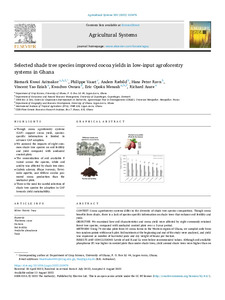| dc.contributor.author | Asitoakor, B.K. |
| dc.contributor.author | Vaast, P. |
| dc.contributor.author | Raebild, A. |
| dc.contributor.author | Ravn, H.P. |
| dc.contributor.author | Eziah, V.Y. |
| dc.contributor.author | Owusu, K. |
| dc.contributor.author | Mensah, E.O. |
| dc.contributor.author | Asare, R. |
| dc.date.accessioned | 2022-09-12T11:14:48Z |
| dc.date.available | 2022-09-12T11:14:48Z |
| dc.date.issued | 2022-10 |
| dc.identifier.citation | Asitoakor, B.K., Vaast, P., Ræbild, A., Ravn, H.P., Eziah, V.Y., Owusu, K., ... & Asare, R. (2022). Selected shade tree species improved cocoa yields in low-input agroforestry systems in Ghana. Agricultural Systems, 202: 103476, 1-9. |
| dc.identifier.issn | 0308-521X |
| dc.identifier.uri | https://hdl.handle.net/20.500.12478/7737 |
| dc.description.abstract | CONTEXT Cocoa agroforestry systems differ in the diversity of shade tree species composition. Though cocoa benefits from shade, there is a lack of species-specific information on shade trees that enhance soil fertility and yield. OBJECTIVE We examined how soil characteristics and cocoa yield were affected by eight commonly retained forest tree species, compared with unshaded control plots over a 3-year period. METHODS Using 74 circular plots from 10 cocoa farms in the Western region of Ghana, we sampled soils from two random points within each plot. Soil nutrients at the beginning and end of the study were analyzed, and yield was expressed as number of harvested pods and dry weight of beans per hectare. RESULTS AND CONCLUSIONS Levels of soil K and Ca were below recommended values. Although soil available phosphorus (P) was higher in control plots than under shade trees, yield around shade trees were higher than on unshaded plots. Cocoa yield differences between shade tree species and control plots were significant only in the major crop season, but not in the minor crop season. Cocoa yields under Cedrela odorata, Khaya ivorensis, Terminalia superba and Milicia excelsa were significantly higher than on control plots. Hence, the inclusion of specific shade tree species in cocoa agroforestry systems is important to maintain high yields in cocoa systems with low inputs. SIGNIFICANCE To our knowledge, this study presents one of the first attempt to assess the impacts of specific shade tree species on soil characteristics and cocoa yield. |
| dc.description.sponsorship | Ministry of Foreign Affairs of Denmark |
| dc.format.extent | 1-9 |
| dc.language.iso | en |
| dc.subject | Theobroma Cacao |
| dc.subject | On-Farm Research |
| dc.subject | Soil Fertility |
| dc.subject | Phosphorus |
| dc.subject | Yields |
| dc.subject | Harvesting |
| dc.subject | Nutrients |
| dc.subject | Agroforestry Systems |
| dc.title | Selected shade tree species improved cocoa yields in low-input agroforestry systems in Ghana |
| dc.type | Journal Article |
| cg.contributor.affiliation | University of Ghana |
| cg.contributor.affiliation | University of Copenhagen |
| cg.contributor.affiliation | Universite de Montpellier |
| cg.contributor.affiliation | International Institute of Tropical Agriculture |
| cg.contributor.affiliation | CSIR-Plant Genetic Resources Research Institute |
| cg.coverage.region | Africa |
| cg.coverage.region | West Africa |
| cg.coverage.country | Ghana |
| cg.coverage.hub | Headquarters and Western Africa Hub |
| cg.researchtheme | Natural Resource Management |
| cg.identifier.bibtexciteid | ASITOAKOR:2022 |
| cg.isijournal | ISI Journal |
| cg.authorship.types | CGIAR and developing country institute |
| cg.iitasubject | Agribusiness |
| cg.iitasubject | Agronomy |
| cg.iitasubject | Cocoa |
| cg.iitasubject | Food Security |
| cg.iitasubject | Nutrition |
| cg.iitasubject | Plant Breeding |
| cg.iitasubject | Plant Production |
| cg.iitasubject | Soil Fertility |
| cg.journal | Agricultural Systems |
| cg.notes | Open Access Article; Published online: 13 Aug 2022 |
| cg.accessibilitystatus | Open Access |
| cg.reviewstatus | Peer Review |
| cg.usagerightslicense | Creative Commons Attribution 4.0 (CC BY 0.0) |
| cg.targetaudience | Scientists |
| cg.identifier.doi | https://dx.doi.org/10.1016/j.agsy.2022.103476 |
| cg.iitaauthor.identifier | Richard Asare: 0000-0001-6798-7821 |
| cg.futureupdate.required | No |
| cg.identifier.issue | 103476 |
| cg.identifier.volume | 202 |

